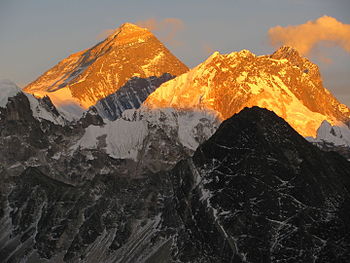| \AL-puh n-gloh\ |
| noun 1. a reddish glow often seen on the summits of mountains just before sunrise or just after sunset. |
| Quotes |
| Now came the solemn, silent evening. Long, blue, spiky shadows crept out across the snow-fields, while a rosy glow, at first scarce discernible, gradually deepened and suffused every mountain-top, flushing the glaciers and the harsh crags above them. This was the alpenglow, to me one of the most impressive of all the terrestrial manifestations of God. -- John Muir, The Mountains of California, 1894 |
| Origin |
| Alpenglow comes from the German word Alpenglühen in which the first element, Alpen, refers to the Alps, and the second element, glühen, means "to glow." It entered English in the mid-1800s. |
| \AL-puh n-gloh\ |
| noun 1. a reddish glow often seen on the summits of mountains just before sunrise or just after sunset. |
| Quotes |
| Now came the solemn, silent evening. Long, blue, spiky shadows crept out across the snow-fields, while a rosy glow, at first scarce discernible, gradually deepened and suffused every mountain-top, flushing the glaciers and the harsh crags above them. This was the alpenglow, to me one of the most impressive of all the terrestrial manifestations of God. -- John Muir, The Mountains of California, 1894 |
| Origin |
Alpenglow comes from the German word Alpenglühen in which the first element, Alpen, refers to the Alps, and the second element, glühen, means "to glow." It entered English in the mid-1800s.Alpenglow
From Wikipedia, the free encyclopedia
Alpenglow (from German: Alpenglühen) is an optical phenomenon in which a horizontal red glowing band is observed on the horizon opposite to the sun. This effect occurs when the Sun is just below the horizon. Alpenglow is easiest to observe when mountains are illuminated but can also be observed when the sky is illuminated throughbackscattering.
Since the Sun is below the horizon, there is no direct path for the light to reach the mountain. Unlike sunset or sunrise, the light that causes alpenglow is reflected off airborne snow, water, or ice particles low in the atmosphere. These conditions differentiate between a normal sunrise or sunset and alpenglow.
Although the term may be loosely applied to any sunrise or sunset light seen on the mountains, true alpenglow is not direct sunlight and is only observed after sunset or before sunrise.
In the absence of mountains, the aerosols in the eastern portion of the sky can be illuminated in the same way at sunset by the remaining red scattered light straddling the border of the Earth's own shadow (the terminator). Thisback-scattered light produces a red band opposite the Sun.
|


No comments:
Post a Comment